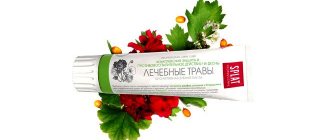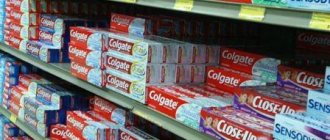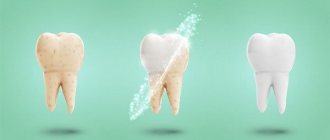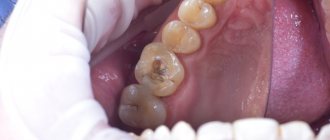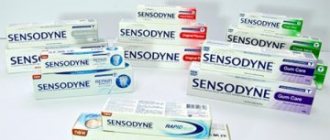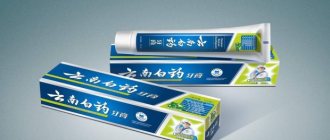- Types of toothpastes
- Properties of toothpastes
- Composition of toothpastes
- Choosing toothpaste according to problem
How many of us buy toothpaste? They make a shopping list and go to the hypermarket. If this sounds like you, then most likely you underestimate the role of toothpaste in your health. A good toothpaste protects against caries, ensures that teeth do not lose minerals, and most importantly, does not harm the enamel. In this article, we will analyze in detail the compositions of modern pastes and tell you how to choose the one that really suits you.
Types of toothpastes
But first, let's discuss the types of pastes. According to GOST 7983-99, all toothpastes are divided into hygienic and therapeutic and prophylactic.
Hygienic pastes are designed for mechanical removal of food debris and plaque from enamel. They contain no drugs.
Therapeutic and prophylactic pastes are intended for the prevention of various oral diseases: caries, gingivitis, periodontal disease. Such pastes have antiseptic and anti-inflammatory effects. Most of them are suitable for daily cleaning.
It would be rational to add another category - medicinal. They must be used strictly in courses - for example, after surgical interventions and other medical procedures. And also for severe dental problems.
Rospotrebnadzor has a different classification of pastes - by purpose. The organization identifies four types of toothpastes with proven effectiveness:
- fluoride-containing (reduce the risk of developing caries and demineralization of enamel);
- with triclosan (have an anti-inflammatory effect in gum diseases);
- whitening agents (help in the fight against dark plaque);
- desensitizing (reduce the increased sensitivity of teeth to sour, hot and cold).
Properties of toothpastes
When choosing a paste, it is important to pay attention to its abrasiveness, composition, consistency and taste. A properly selected paste will not only bring benefits, but will also make the cleaning process more enjoyable.
Abrasiveness
The abrasiveness of the toothpaste determines the intensity of the impact on the enamel. The degree of abrasiveness depends not only on the number of abrasive particles, but also on their size. The larger they are, the more they polish the enamel. The number and size of particles form the abrasiveness index, which is indicated on the paste packaging with the abbreviation RDA.
- If you have sensitive teeth and gums, choose low-abrasive toothpastes with an RDA of 20 to 50
. - If you don't have dental problems, moderately abrasive toothpastes with an RDA of 50 to 80
. - Pastes with RDA from 80 to 110
polish the enamel, providing a slight brightening effect. They should not be used daily. - Pastes with an RDA above 120
have an intense brightening effect. Not recommended for chipped and cracked enamel, as well as for increased tooth sensitivity. - For children under 2 years old, it is better to choose a paste with RDA 0
, from 2 years old - no more than 20.
Consistency
In addition to the composition, the thickness of the paste is also important. To ensure that the paste is evenly squeezed out of the tube and does not separate, manufacturers add thickeners and emulsifiers to the composition. They are used not only in toothpastes, but also in cosmetics, food and special gels for teeth (for example, miradent mirasensitive hap+).
Taste and smell
The paste should not only be beneficial and safe, but you should also like it. The taste and smell should not cause unpleasant sensations. Choose based on your own preferences - today pastes are made not only with the classic mint taste.
The fruity flavors of Curaprox pastes will help diversify your everyday life. They have unusual combinations: watermelon and mint, apple and aloe, blackberry and licorice.
Of the available pastes, you can experiment with SPLAT and President. At SPLAT you will find the flavors “Siberian berries”, “Raspberry”, “Strawberry” and even “Chili”. President's Limited Edition series has three vibrant flavors: Berry Smoothie, Mint Lime and Spicy Cranberry.
Brushing your teeth with Marvis toothpastes will turn into an aesthetic pleasure. They come in ginger, jasmine, cinnamon, cherry, citrus, licorice and rhubarb flavors.
Taste is especially important in children's toothpastes, because not only do children like it, but it also helps accustom the baby to the routine of daily brushing.
But it’s worth making a reservation: the pleasant taste of pasta should not be the main criterion for its selection.
Fluoridate all drinking water
It precipitates, and all its possible benefits are instantly reduced to zero. Toothpastes intended for sensitive teeth often use stannous fluoride (Oral-B). However, not everyone who buys such pastes is aware that, as a side effect, their teeth and fillings can turn yellow-brown. Besides this, did you know that the world has been arguing about the benefits and harms of fluoride for more than sixty years? It all started with the fact that in the forties of the last century in the USA the positive effect of fluoride on the healing of tooth enamel was discovered. It turned out that fluoride can literally patch holes in teeth. After this, scientists stated that in areas with a lack of fluoride in the population’s diet, the overall incidence of caries is increased, and they decided to fluoridate all drinking water, since it is with water that natural fluoride enters the body. There are also rumors about completely different prerequisites for the fluoridation of humanity.
Aluminum magnates and chemical concerns, which in those years had absolutely nowhere to dispose of fluorine-containing waste from their production. They say that when they learned about the discoveries of scientists, they quickly jumped in and hooked America on fluoride. At the same time, fluorides began to be added to toothpaste. Now we need to say a few words about what fluorine actually is. An adult's need for this element is 2-3 mg/day. At the same time, a person receives one third of fluoride from food and two from water.
Composition of toothpastes
When choosing a paste, pay attention not only to its purpose, smell or taste, but also to its composition. This is important if you have allergies - the pastes contain many components, including herbal ones. Choose a paste that contains a minimum of preservatives, colors and foaming agents (SLS).
What should be included?
In addition to active substances, toothpaste also contains thickeners, binders and other substances. Don’t be afraid of the names in the composition - all these components are needed so that the paste has a uniform structure, does not dry out, is stored well, etc.
Fluorine
. An important substance that restores the structure of enamel, strengthens it, kills bacteria, prevents plaque formation and the development of caries. The fluorine content must be age-appropriate: up to 3 years - up to 200 ppm, up to 7 years - no more than 500 ppm, up to 14 years - no more than 1400 ppm.
Choose pastes with sodium fluoride or amino fluoride. It is these compounds that have the strongest anti-caries and remineralizing effect. We talk more about the importance of fluoride in a separate article.
Calcium
- the main element of the skeletal system. This mineral strengthens teeth and protects them from caries. Paste with calcium can eliminate caries in the initial stage.
Fluoride and calcium are equally important for enamel remineralization, but when combined they form an insoluble salt and neutralize each other's effects.
The solution is to alternate pastes with calcium and fluorine and make sure that one paste does not contain fluoride and calcium compounds at the same time. Pyrophosphates
. They prevent the appearance of plaque and tartar, slow down the growth of pathogenic bacteria that cause caries and unpleasant odor.
Zinc citrate
. Antiseptic, blocks the growth of bacteria and the hardening of minerals that form tartar.
Xylitol
. One of the most effective natural components for protection against caries. Actively fights bacteria, restores enamel and increases its strength, moisturizes the oral cavity. You can learn more about xylitol in our article.
Urea peroxide
. Organic hydrogen compound. Powerful and most effective enamel whitening product. Does not damage enamel. We wrote about how whitening with peroxides works here.
Papain, bromelain
. Natural enzymes that lighten enamel naturally. They give a more delicate and not as strong whitening effect as peroxides.
Chlorhexidine
. A powerful antiseptic that disinfects, promotes healing of mucosal wounds, and kills pathogenic bacteria. Unlike natural extracts, it is suitable for use only in courses, as it can harm the beneficial microflora of the oral cavity. We wrote more about pastes with antiseptics here.
Natural extracts
(oak bark, sage, chamomile, etc.). Natural anti-inflammatory and antiseptic components that can be used daily. Effective complementary therapy for minor bleeding and inflammation of the gums.
Hydroxyapatite
. A modern and effective product for restoring and renewing enamel. Fills microcracks and prevents the formation of caries. Read more about remineralization in our article.
Peptides
. Organic substances that restore damaged gum tissue by normalizing its functioning at the cellular level. Pastes, as a rule, contain low molecular weight peptides - thymus peptides, vascular peptides, peptides of cartilage and bone tissue.
What should not be in the paste?
SLS/SLES
. Thanks to them, the paste foams - the more of them, the more fluffy the foam. Contrary to popular myth, the quality of cleaning does not depend on the amount of foam. With frequent use of paste with SLS/SLES, the protective barrier of the oral mucosa is destroyed, dryness and even allergies appear.
Triclosan and triclogard
. Strong antibiotics, which negatively affect the immune system and microflora of the oral cavity, also kill beneficial bacteria. But they are used for some diseases of the oral cavity - in courses and on the recommendation of a doctor.
Calcium carbonate
. Included in inexpensive pastes as an abrasive. It leaves scratches on the enamel, disrupts its structure and contributes to the formation of the early stages of caries - white spots.
SPLAT Biocalcium
This product is a complex product. The bioactive substance is obtained from egg shells. Hydroxyapatite, which is part of the product, is a building element for hard tissues. The enamel is strengthened due to the high content of active components. They quickly reduce the increased vulnerability of crowns. A natural enzyme such as papain minimizes the risk of accumulation of dirty plaque and bacterial stone.
Normalization of pH balance is achieved through sodium bicarbonate. The product takes care of gum tissue. It safely brightens and polishes crowns. Problems are solved by saturating the damaged areas of the units with natural calcium, especially in the initial stages. Natural enzymes promote fresh breath. A noticeable result will appear after a week of using the product.
Choosing toothpaste according to problem
When choosing a toothpaste, base it on your current dental situation or problem that is bothering you. Use different pastes in the morning and evening. For example, in the morning - whitening, in the evening - restoring enamel. Change pastes over time - you shouldn’t use the same favorite one all your life.
Raid
Even with healthy teeth and gums, you need to remember about prevention. Daily high-quality cleaning of plaque helps to avoid many problems - unpleasant odor, tartar, caries and gum inflammation.
Strike after strike - discord. Everyone has a mild bacterial plaque, and any good paste should cope with it. But there is a tendency to increased plaque formation or persistent pigmentation due to smoking, coffee, red wine and other coloring products. And this already requires special hygiene products.
It is important to remember here: if plaque is not removed well, it will turn into tartar. You can deal with plaque on your own, but you can deal with tartar only in the dentist’s office.
Choose pastes for daily use with an abrasiveness of no higher than 80 and a fluorine or hydroxyapatite content of at least 950 ppm. Complete your care with an irrigator and mouth rinse.
Unpleasant smell
Bad breath (or halitosis) causes self-doubt for many people. A slight odor from the mouth in the morning is normal. A sharp unpleasant odor that persists throughout the day indicates the presence of some kind of pathology.
The cause of halitosis is the formation of volatile sulfur compounds in the mouth, which are released by bacteria. This happens due to poor hygiene, caries, gum inflammation, and smoking. Halitosis can also be associated with diseases of the gastrointestinal tract, respiratory system and kidneys, diabetes mellitus, taking medications, etc. If serious causes of halitosis are excluded, you can cope with it on your own.
Many manufacturers say that their pastes eliminate bad breath. In reality, they simply disguise it for a while.
Choose antibacterial paste. The composition must contain active components that eliminate volatile sulfur compounds. First of all, it is zinc. Only then will the paste not mask, but actually solve the problem. The composition may also include eucalyptus and thymol oils and charcoal. It is worth supplementing the care with a mouthwash containing the same ingredients.
Sensitive enamel
The problem of enamel sensitivity requires careful and gentle cleaning - any strong impact can cause pain and make it worse. If your teeth react to hot, cold, or sharp things, low-abrasive pastes with an RDA of no higher than 30 are suitable for you. For particularly sensitive enamel, choose pastes with hydroxyapatite, fluorine or calcium in the composition. They will strengthen the enamel, reduce its sensitivity and prevent the problem from reoccurring.
Sensitive gums
Irregular and poor oral hygiene is one of the main causes of inflammation and bleeding gums. An integrated approach is needed here.
Choose pastes containing chlorhexidine, plant extracts (oak bark, sage, chamomile, etc.), allantoin, essential oils (menthol, thymol). To pair with the paste, choose a brush with soft bristles. And don't forget to change it every 3 months. Complete your care with a rinse for sensitive gums.
In the later stages of periodontal disease, pastes with more powerful antiseptics are used: triclosan, chlorine dioxide, zinc. They help remove unpleasant odor, protect gums from inflammation and slow down the accumulation of bacteria. What they all have in common is that they destroy not only pathogenic microorganisms, but also, over time, beneficial microflora. Such pastes can be used in courses of no more than 2-3 weeks, in rare cases - up to 1 month. Otherwise, they can cause oral dysbiosis.
Color change
The reasons for darkening of the enamel can be very different - poor cleaning, smoking, frequent consumption of coffee, tea, red wine. For darkened teeth, a toothpaste with a whitening effect is suitable. If you want to restore natural whiteness or prolong the effect of professional whitening, choose pastes containing papain, bromelain, and carbamide peroxide.
Plaque from coloring products should be removed with abrasive pastes, and the dentin under the enamel should be lightened with the help of peroxides. Thus, carbamide peroxide is the most effective whitening component. And if the paste contains various strengthening and restoring substances, you get not only a whitening effect, but also comprehensive care.
Prevention of caries
Caries is the most common disease in the world. This is a pathological process of destruction of hard tooth tissues. It begins with a white spot and ends with pulpitis and various septic processes with inevitable tooth loss.
The main cause of caries is bacteria that produce acids. They wash fluoride and calcium out of the tooth tissue and weaken it. Frequent consumption of sweets accelerates the development of carious bacteria: carbohydrates are a favorite environment for their reproduction. Teeth with thinned enamel are also at risk: through microcracks, bacteria penetrate into the dentinal tubules and begin to destroy the tooth from the inside.
The most important stage in effectively combating caries is early diagnosis of the problem and, of course, prevention. Remove plaque at least once every 12 hours. Use pastes that contain sodium monofluorophosphate, sodium fluoride, amino fluorides, calcium glycerophosphate, xylitol. They strengthen enamel, fill microcracks and can even cure caries at the white spot stage. Supplement your care by using an irrigator to clean the interdental spaces - the place where a brush fails and where caries most often begins.
Prevention of caries is especially important during pregnancy, when the body actively spends a huge amount of calcium. Therefore, you need to select a remineralizing, anti-caries paste. It should not contain SLS, parabens, synthetic dyes, or a high RDA index.
Fluoride compounds, food additives, fluoride tablets
The population knows nothing about such concern from the local government. And people buy toothpaste without knowing what kind of water flows from their taps. So, the eternal Russian question: what to do? Unbiased dentists answer this question as follows: The emergence, in addition to water fluoridation, of other sources of fluoride compounds, such as food additives, fluoride tablets or toothpastes, may mean that changes are necessary in the overall picture of fluoridation, which will require additional research, regulation of the supply of fluoride-containing pastes to regions with a high fluoride content in the diet of the local population. That is, research has yet to be carried out, and supplies have yet to be regulated by the grazing of drowning people - the work of the drowning people themselves. Think with your head, change the paste more often, do not use the same paste morning and evening, and carefully read what is written on the tubes in the smallest letters.
